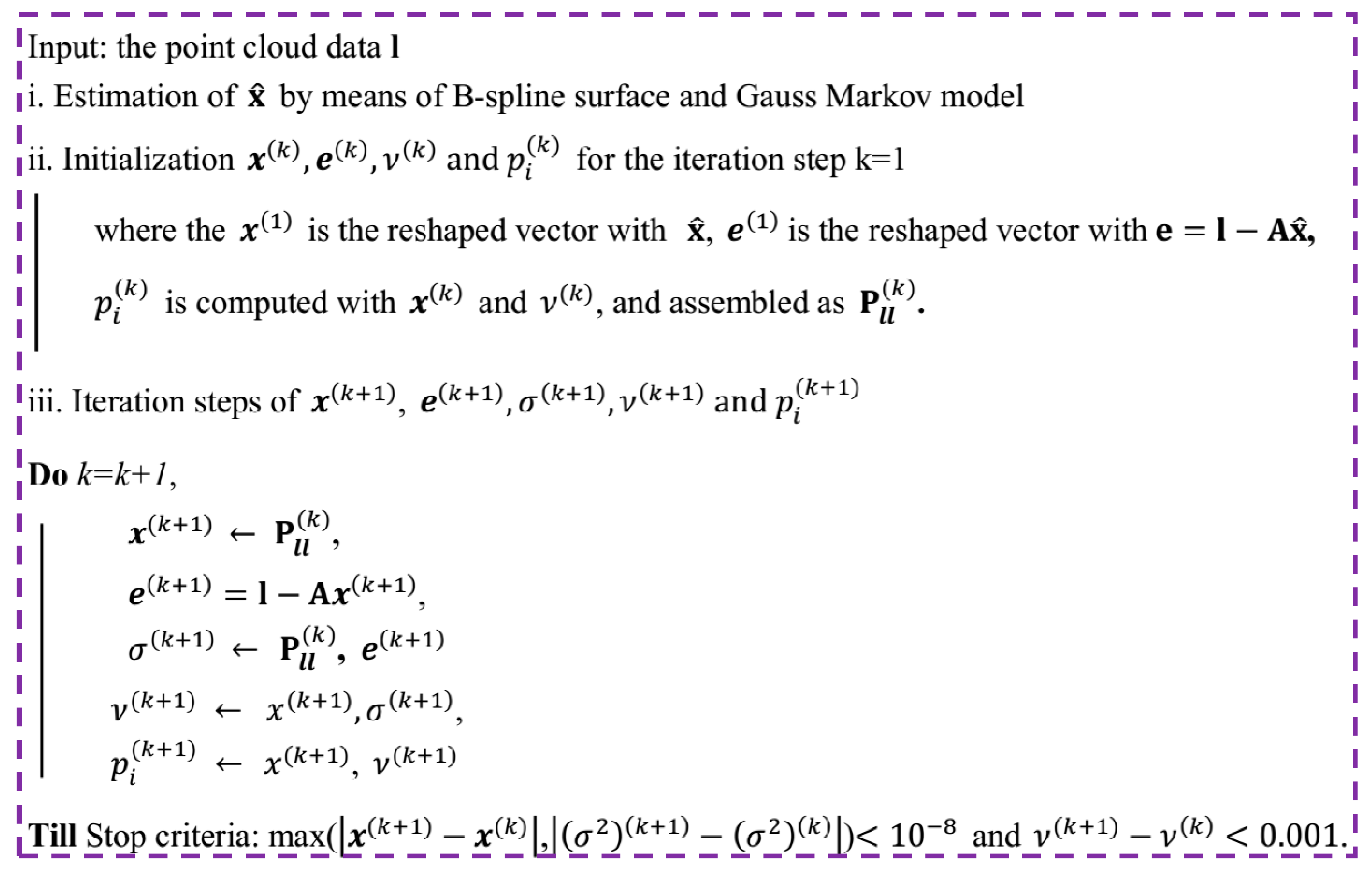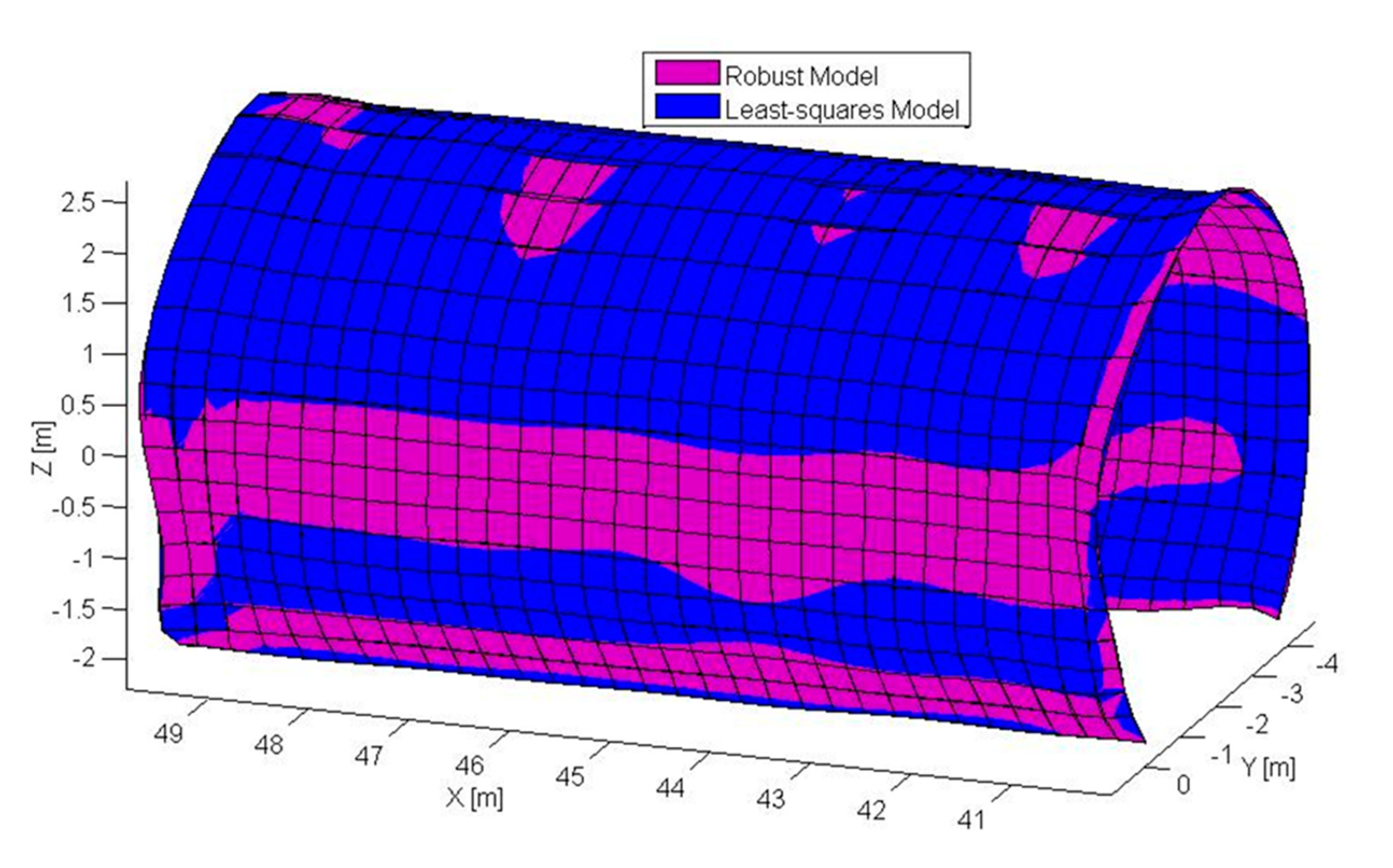Vision Measurement of Tunnel Structures with Robust Modelling and Deep Learning Algorithms
Abstract
:1. Introduction
2. Measurement
3. Data Analysis
3.1. Robust 3D Modelling
3.2. Crack Analysis
4. Results
5. Discussion
6. Conclusions
- (i)
- A measurement of the tunnel structures is carried out with the vision-based method where ten cameras are installed in the vehicle and collect image data of the inner wall of the tunnel.
- (ii)
- The AI-based crack identification method is investigated in which deep learning based on CNN is employed.
- (iii)
- The 3D freeform surface is generated where the maximum likelihood function is applied to improve the robustness of the modelling.
- (iv)
- The global parameterization of the tunnel from images is computationally efficient, robust against disturbing data and convenient for visualization.
- (v)
- The robust model gains significant improvement compared to the least-squares model in terms of RMSE where the improvements in two segmentations are 429.32% and 425.06%.
Author Contributions
Funding
Acknowledgments
Conflicts of Interest
References
- Attard, L.; Debono, C.J.; Valentino, G.; Di Castro, M. Tunnel inspection using photogrammetric techniques and image processing: A review. ISPRS J. Photogramm. Remote Sens. 2018, 144, 180–188. [Google Scholar] [CrossRef]
- Cho, S.; Park, S.; Cha, G.; Oh, T. Development of image processing for crack detection on concrete structures through terrestrial laser scanning associated with the octree structure. Appl. Sci. 2018, 8, 2373. [Google Scholar] [CrossRef] [Green Version]
- Murakami, T.; Saito, N.; Komachi, Y.; Okamura, K.; Michikawa, T.; Sakashita, M.; Midorikawa, K. High Spatial Resolution Survey Using Frequency-Shifted Feedback Laser for Transport Infrastructure Maintenance. J. Disaster Res. 2017, 12, 546–556. [Google Scholar] [CrossRef]
- Afshanii, A.; Akagi, H.; Konishi, S. Investigate the detection rate of defects in concrete lining using infrared-thermography method. In Proceedings of the 7th China-Japan Geotechnical Symposium: New Advances in Geotechnical Engineering, Sanya, China, 16–18 March 2018; pp. 1–5. [Google Scholar]
- Daneshgaran, F.; Zacheo, L.; Stasio, F.D.; Mondin, M. Use of Deep Learning for Automatic Detection of Cracks in Tunnels: Prototype-2 Developed in the 2017–2018 Time Period. Transp. Res. Rec. 2019, 2673, 44–50. [Google Scholar] [CrossRef]
- Hirata, T.; Goda, Y.; Sakai, K.; Kiwa, T.; Adachi, S.; Tsukamoto, A.; Tsukada, K. Development of a Highly Sensitive Magnetic Field Detector With a Wide Frequency Range for Nondestructive Testing Using an HTS Coil With Magnetic Sensors. IEEE Trans. Appl. Supercond. 2019, 29, 1–5. [Google Scholar] [CrossRef]
- Loupos, K.; Doulamis, A.D.; Stentoumis, C.; Protopapadakis, E.; Makantasis, K.; Doulamis, N.D.; Menendez, E. Autonomous robotic system for tunnel structural inspection and assessment. Int. J. Intell. Robot. Appl. 2018, 2, 43–66. [Google Scholar] [CrossRef]
- Lee, J.S.; Hwang, S.H.; Choi, I.Y.; Choi, Y. Estimation of crack width based on shape-sensitive kernels and semantic segmentation. Struct. Control Health Monit. 2020, 24, e2504. [Google Scholar] [CrossRef]
- Medina, R.; Llamas, J.; Gómez-García-Bermejo, J.; Zalama, E.; Segarra, M.J. Crack detection in concrete tunnels using a Gabor filter invariant to rotation. Sensors 2017, 17, 1670. [Google Scholar] [CrossRef]
- Son, H.; Kim, C. Automatic segmentation and 3D modeling of pipelines into constituent parts from laser-scan data of the built environment. Autom. Constr. 2016, 68, 203–211. [Google Scholar] [CrossRef]
- Laefer, D.F.; Truong-Hong, L. Toward automatic generation of 3D steel structures for building information modelling. Autom. Constr. 2017, 74, 66–77. [Google Scholar] [CrossRef]
- Valero, E.; Adán, A.; Bosché, F. Semantic 3D reconstruction of furnished interiors using laser scanning and RFID technology. J. Comput. Civ. Eng. 2016, 30, 04015053. [Google Scholar] [CrossRef]
- Ullah, A.M.M.; Watanabe, M.; Kubo, A. Analytical Point-Cloud Based Geometric Modeling for Additive Manufacturing and Its Application to Cultural Heritage Preservation. Appl. Sci. 2018, 8, 656. [Google Scholar]
- Jeon, J.; Jung, J.; Kim, J.; Lee, S. Semantic Reconstruction: Reconstruction of Semantically Segmented 3D Meshes via Volumetric Semantic Fusion. Comput. Graph. Forum 2018, 37, 25–35. [Google Scholar] [CrossRef]
- Yang, H.; Xu, X.; Kargoll, B.; Neumann, I. An automatic and intelligent optimal surface modeling method for composite tunnel structures. Compos. Struct. 2019, 208, 702–710. [Google Scholar] [CrossRef]
- Díaz-Vilariño, L.; Khoshelham, K.; Martínez-Sánchez, J.; Arias, P. 3D modeling of building indoor spaces and closed doors from imagery and point clouds. Sensors 2015, 15, 3491–3512. [Google Scholar] [CrossRef] [Green Version]
- Xu, X.; Kargoll, B.; Bureick, J.; Yang, H.; Alkhatib, H.; Neumann, I. TLS-based profile model analysis of major composite structures with robust B-spline method. Compos. Struct. 2019, 184, 814–820. [Google Scholar] [CrossRef]
- Yang, H.; Xu, X.; Neumann, I. Optimal finite element model with response surface methodology for concrete structures based on Terrestrial Laser Scanning technology. Compos. Struct. 2018, 183, 2–6. [Google Scholar] [CrossRef]
- Xu, X.; Yang, H.; Zhang, Y.; Neumann, I. Intelligent 3D data extraction method for deformation analysis of composite structures. Compos. Struct. 2018, 203, 254–258. [Google Scholar] [CrossRef]
- Yang, H.; Xu, X.; Neumann, I. Laser Scanning-Based Updating of a Finite-Element Model for Structural Health Monitoring. IEEE Sens. 2016, 16, 2100–2104. [Google Scholar] [CrossRef]
- Xu, X.; Bureick, J.; Yang, H.; Neumann, I. TLS-based composite structure deformation analysis validated with laser tracker. Compos. Struct. 2018, 202, 60–65. [Google Scholar] [CrossRef]
- Yang, H.; Xu, X. Multi-sensor technology for B-spline modelling and deformation analysis of composite structures. Compos. Struct. 2019, 224, 111000. [Google Scholar] [CrossRef]
- Yang, H.; Xu, X.; Xu, W.; Neumann, I. Terrestrial Laser Scanning-Based Deformation Analysis for Arch and Beam Structures. IEEE Sens. J. 2017, 17, 4605–4611. [Google Scholar] [CrossRef]
- Wiśniewski, Z.; Kamiński, W. Estimation and Prediction of Vertical Deformations of Random Surfaces, Applying the Total Least Squares Collocation Method. Sensors 2020, 20, 3913. [Google Scholar] [CrossRef] [PubMed]
- Ziolkowski, P.; Szulwic, J.; Miskiewicz, M. Deformation Analysis of a Composite Bridge during Proof Loading Using Point Cloud Processing. Sensors 2018, 18, 4332. [Google Scholar] [CrossRef] [Green Version]
- Barazzetti, L.; Scaioni, M. Development and Implementation of Image-based Algorithms for Measurement of Deformations in Material Testing. Sensors 2010, 10, 7469–7495. [Google Scholar] [CrossRef] [Green Version]
- Piegl, L.; Tiller, W. The NURBS Book, 2nd ed.; Springer: Berlin, Germany; New York, NY, USA, 1997. [Google Scholar]
- Koch, K.; Kargoll, B. Expectation maximization algorithm for the variance-inflation model by applying the t-distribution. J. Appl. Geod. 2013, 7, 217–225. [Google Scholar] [CrossRef]
- He, K.; Zhang, X.; Ren, S.; Sun, J. Deep residual learning for image recognition. In Proceedings of the IEEE Conference on Computer Vision and Pattern Recognition, Las Vegas, NV, USA, 27–30 June 2016; pp. 770–778. [Google Scholar]
- Gibert, X.; Patel, V.M.; Chellappa, R. Deep multitask learning for railway track inspection. Ieee Trans. Intell. Transp. Syst. 2016, 18, 153–164. [Google Scholar] [CrossRef] [Green Version]
- He, K.; Zhang, X.; Ren, S.; Sun, J. Delving deep into rectifiers: Surpassing human-level performance on imagenet classification. In Proceedings of the IEEE International Conference on Computer Vision, Santiago, Chile, 7–13 December 2015; pp. 1026–1034. [Google Scholar]








| Layer Name | Details | Output |
|---|---|---|
| conv1 | 7 × 7, 64, stride 2 | 112 × 112 |
| conv2_x | 3 × 3 max pooling, stride 2 | 56 × 56 |
| conv3_x | 28 × 28 | |
| conv4_x | 14 × 14 | |
| conv5_x | 7 × 7 | |
| Average pooling + Fully connected layer | 1 × 1 |
| Model/Point Cloud Datasets | Segmentation 1 | Segmentation 2 |
|---|---|---|
| Least-squares Model | 18.95 | 23.26 |
| Robust Model | 3.58 | 4.43 |
| RMSE improvement | 429.32% | 425.06% |
© 2020 by the authors. Licensee MDPI, Basel, Switzerland. This article is an open access article distributed under the terms and conditions of the Creative Commons Attribution (CC BY) license (http://creativecommons.org/licenses/by/4.0/).
Share and Cite
Xu, X.; Yang, H. Vision Measurement of Tunnel Structures with Robust Modelling and Deep Learning Algorithms. Sensors 2020, 20, 4945. https://doi.org/10.3390/s20174945
Xu X, Yang H. Vision Measurement of Tunnel Structures with Robust Modelling and Deep Learning Algorithms. Sensors. 2020; 20(17):4945. https://doi.org/10.3390/s20174945
Chicago/Turabian StyleXu, Xiangyang, and Hao Yang. 2020. "Vision Measurement of Tunnel Structures with Robust Modelling and Deep Learning Algorithms" Sensors 20, no. 17: 4945. https://doi.org/10.3390/s20174945
APA StyleXu, X., & Yang, H. (2020). Vision Measurement of Tunnel Structures with Robust Modelling and Deep Learning Algorithms. Sensors, 20(17), 4945. https://doi.org/10.3390/s20174945




